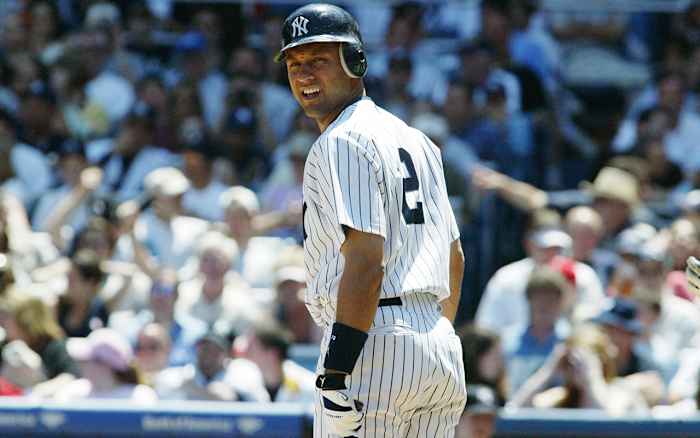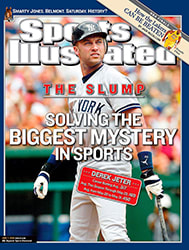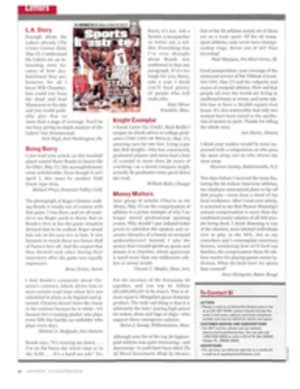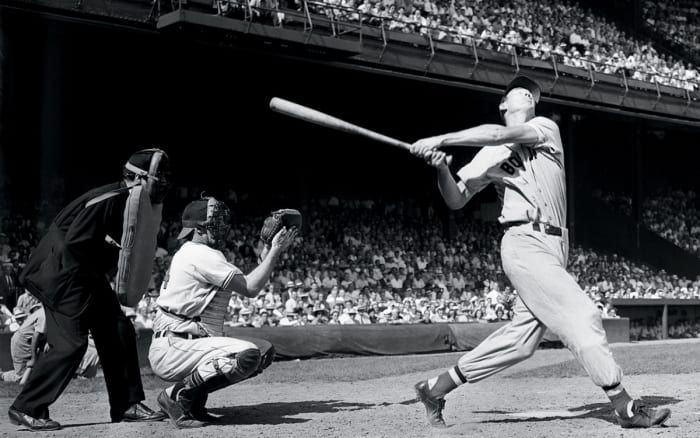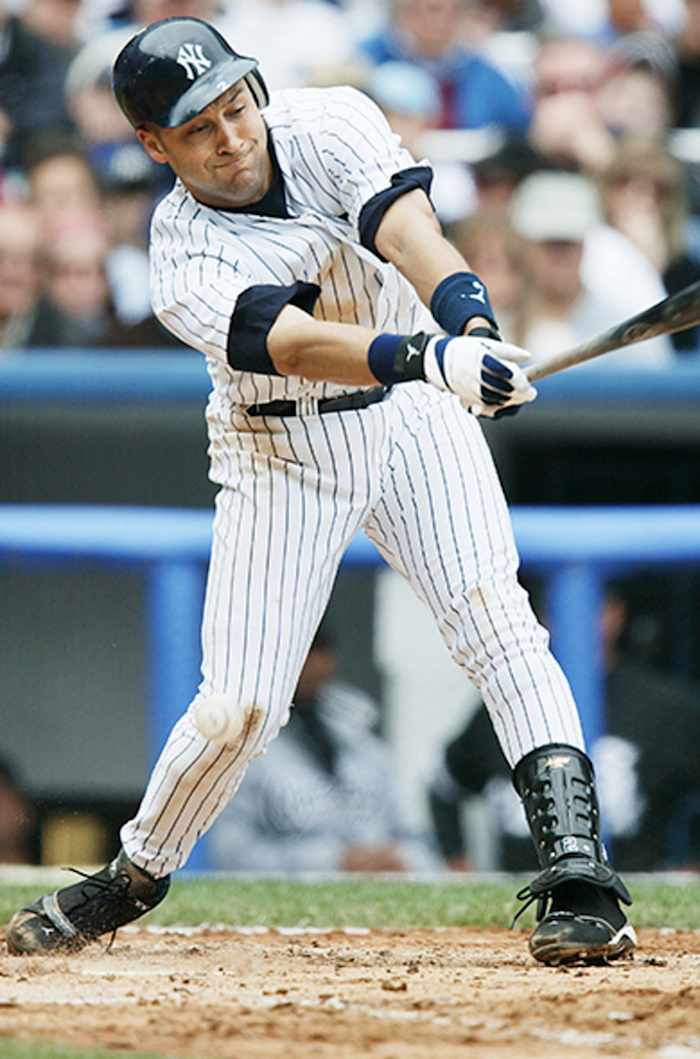Hitting Bottom
A batting slump is baseball's version of the common cold. Sooner or
later every hitter gets one, it can keep him up at night, and
there is no known cure, though that does not prevent everyone and
his doorman from passing on homemade remedies and get-well
wishes. Derek Jeter of the New York Yankees came down with a
whopper of a case in April--he was 0 for 32 at its head-throbbing
worst--that was so bad that he couldn't leave his Manhattan
apartment without being reminded of it.
"The doorman would tell me, 'Tonight's the night! I've got a
feeling this is it!'" Jeter says. "You're trying not to think
about it, yet everywhere you go, you're constantly reminded of
it. It wasn't so much people giving me advice as it was people
saying, 'We're pulling for you.' It's everywhere you
turn--people on the street, the questions from the media every
day."
This season has produced even more proof that no one is immune.
Career .300 hitters Jeter, Chipper Jones of the Atlanta Braves
and Jose Vidro of the Montreal Expos--who ranked seventh, 12th
and 18th, respectively, in career batting average among active
players entering this season--all were hitting worse than .250 at
week's end. Fellow perennial All-Stars Carlos Delgado of the
Toronto Blue Jays (.227), Bret Boone of the Seattle Mariners
(.231) and Shawn Green of the Los Angeles Dodgers (.229) were
similarly stricken. Welcome to the cold-and-flew-out-weakly-to-
leftfield season.
"These guys are all proven hitters, and they're not old, either,"
Milwaukee Brewers general manager Doug Melvin says. "I think [at
the end of the season] the numbers will be there. But some are
digging such a big hole that they won't be able to put up the big
numbers they have in the past."
Jones, for instance, had only two doubles and 13 RBIs at week's
end, jeopardizing his streaks of five years with 30 doubles and
eight years with 100 RBIs. Delgado, who suffered a sprained rib
cage muscle while swinging against the Texas Rangers last
Saturday, had eight homers and 32 RBIs, and was facing an uphill
climb to continue his streak of six consecutive seasons with at
least 33 homers and 102 RBIs.
For young hitters, a slump can infect an entire year, which is
what happened last season to the Philadelphia Phillies' Pat
Burrell (.209), the Cincinnati Reds' Adam Dunn (.215) and the
Chicago White Sox' Paul Konerko (.234). Jeter, however, showed
last week how stars with long track records of success can get
well soon. Entering the Yankees' May 26 game against the
Baltimore Orioles, Jeter, who hit .324 in 2003, was batting .189
after 190 at bats. Suddenly, facing the Orioles and the Tampa Bay
Devil Rays, he pounded out 11 hits in his next 24 at bats,
raising his average 31 points in five days, to .220. To hit .300
for the season--assuming he maintained his rate of at bats--Jeter
would need to hit .335 the rest of the way, not an unreasonable
task for a career .317 hitter entering the season.
"I didn't see how people could be writing my obituary after one
month," Jeter said last Saturday before hitting safely in his
sixth straight game. "I knew all along there was a lot of the
season left to play, so I wasn't concerned. It's frustrating when
you're not getting your hits. I'm not going to lie to you about
that. But you don't spend time thinking about what's already
happened. You can't change it. You just look forward to the next
game, especially when you know there are about 120 left."
Not coincidentally, the Yankees also began to look more like
themselves last week, putting together their highest-scoring (61
runs) six-game winning streak in 46 years. After an 8-11 start
during which they batted .217, the Yankees had the best record
(30-19) and the most runs (275) in baseball--and their average
was up to .265. "We feed off his energy, without a doubt,"
Yankees third baseman Alex Rodriguez says of shortstop Jeter.
"He's a hitting machine. A lot of good things happen when he gets
going. He's the heartbeat of this team."
The slump--or at least its derivation in the English
language--traces from the appropriately cold climes of
Scandinavia and the Norwegian verb slumpa ("to fall"). In America
a slumpa can take on many forms, though none as vivid as the one
that falls at the beginning or end of a season and strikes a star
player. Combine those elements, and you get historic droughts at
the plate, such as the 0 for 21 suffered in the 1952 World Series
by the Dodgers' Gil Hodges, whose slump the following season
prompted Brooklyn priests to entreat their parishioners to pray
for him; the 5-for-25 performance by the Boston Red Sox' Ted
Williams in the 1946 World Series, which turned out to be his
only postseason appearance; and Jeter's 0-for-32 run, which drew
much more attention than the virtually simultaneous 0-for-37 skid
by the Devil Rays' Jose Cruz Jr., a lifetime .251 hitter.
Bob Uecker, the former backup catcher, once said, "I had slumps
that lasted into the winter." But with players such as Uecker, a
career .200 hitter, it's hard to tell when a slump begins and
ends. Likewise, pitcher Bob Buhl owns the worst 0-fer in major
league history--0 for 88 over two seasons--but he was a career
.089 hitter.
Dodgers infielder Robin Ventura went 0 for 41 as a rookie with
the White Sox in 1990. Hall of Fame shortstop Luis Aparicio once
endured an 0-for-44 slump. For position players, however, the
sultan of slump is Bill Bergen, a Brooklyn catcher who went 0 for
46 in 1909 on his way to becoming the worst hitter of all time
(minimum 1,000 at bats), with a .170 batting average over 11
seasons. That an accomplished hitter such as Jeter could look
like Bergen is testament to the humbling nature of baseball.
"Slumps are powerful things," says Rodriguez, who endured an
0-for-21 stretch with the Rangers in 2002. "Sometimes players are
going so badly that, if they hit a pop-up near the third base
stands, they root for the ball to stay in play so the third
baseman can catch it, just so they don't strike out again. I've
heard of guys telling the catcher, 'Just tell me what pitch is
coming because there's no way I'm getting a hit right now and I
don't want to punch out again. Just let me put one ball in
play.'"
Says Yankees DH Jason Giambi, "Oh, yeah, there are times you're
going so bad you swing at the first pitch just so you don't get
to another two-strike count, because you know you'll strike out.
So you'll take your ground ball to second base and get out of
there thinking, O.K., at least I made contact. That's something."
Slumps can be all-consuming, affecting a hitter's mood, appetite
and behavior. Former Yankees outfielder Paul O'Neill says that
when he was in a slump, it "never really left me. It was what I
thought about as I went to bed and the first thing when I got up
in the morning."
Says Devil Rays manager Lou Piniella, a former player notorious
for his intensity, "When you're in a slump, thank God for the
invention of the watercooler."
Slumps would awaken Piniella, a lifetime .291 hitter, in the
middle of the night and, eventually, would rouse his wife too.
Anita Piniella would hear yelling coming from downstairs and fear
a burglar had entered the house. Instead she would find her
frustrated husband swinging a bat in front of a mirror, talking
to himself.
Hitting is an art with karmic overtones. Cold streaks are charged
by the static of many disjointed thoughts. Hot streaks are marked
by the absence of thought, or as the yogi Berra once
philosophized, "How the hell are you going to think and hit at
the same time?"
Like an artist visited by a muse, the hitter has an elusive
relationship with the baseball goddess known as Feel. Explains
Yankees centerfielder Bernie Williams, "You get the feeling that
they can't get you out. It's something that seems to come from
your inner being. You can't wait for your next at bat. It's like
riding a wave, being right in the middle of a 50-foot swell and
riding it all the way in to shore, and then you paddle back out
and do it as long as you can. And then [the feeling's] gone."
The loss of that feeling, however, can have practical
explanations. As Jones says, "When I'm not hitting, 95 percent of
the time it's something mechanical. So the key is to figure out
what the mechanical flaw is. You get in the cage and try to work
yourself out of it. The other five percent of the time, it's
mental. Every time you go to the plate, you feel like they've got
12 people out on the field, there are no holes, and you're not
going to get any hits."
Jeter's slump had mental and physical origins. As he pressed to
get off to a good start, Jeter admits, his anxiety had him
"jumping at the ball." Rather than waiting for a pitch to get to
him, especially an outside pitch, Jeter would lean forward in his
haste to hit it, jerking his head instead of keeping it steady.
He was particularly hard-pressed to hit fastballs, which he had
previously feasted on (below). Last year, for instance, he batted
.330 against fastballs from righthanders on the outer third of
the plate, according to the scouting service Inside Edge. In his
first 43 games this year, however, Jeter was hitless in 16 at
bats decided by those same pitches. He struggled when hitting
with two strikes (.127, versus .235 in 2003) and even when he was
ahead in the count (.250, versus .459). Furthermore, his
"well-hit average"--Inside Edge's category for hard-hit balls,
regardless of whether they end up as base hits--dropped from .316
to .245.
"You're trying so hard to get hits instead of just hitting the
ball," Jeter says. "But you can't guide the ball. Your eyes are
the key. When your head moves, your eyes move, and you don't see
the pitch as long. That's why when you're going good, the ball
looks slower. You see it longer. Now I'm staying back, letting
the ball get to me instead of trying to go out and get the ball."
Moreover, Jeter sometimes caught himself guessing the type and
location of the next pitch. "I'm no good when I look for
pitches," he says, "because if I look for something [and it comes
close to that location], I'll swing no matter what. Like if I'm
looking inside, the pitch could be about to hit me and I'll still
swing at it."
Before his 0-for-32 slide, Jeter had never gone more than 18 at
bats without a hit. When he finally ended the slump with a
leadoff home run against Barry Zito of the Oakland A's on April
29, he said after the game, "It's like a bad dream is over with."
He added, "I wouldn't wish it on anybody." Not long thereafter,
he fell into a 1-for-26 funk.
"[It] never really changed much," Giambi said about Jeter's
demeanor, "and that's hard to do when it seems like nothing is
going right. I remember in Boston he hit a couple of line drives
to rightfield that would have been hits except Kevin Millar was
playing a Little League rightfield. When you're going bad, guys
make plays on you that they're not supposed to make."
Says Jeter, "I never lose my confidence. It doesn't mean I'm
going to get hits, but I have my confidence all the time."
According to New York manager Joe Torre, two of Jeter's three
hits--flared doubles--in his breakout game against Baltimore were
typical slump breakers. "All of a sudden you realize you don't
have to hit it on the screws to get a hit," says Torre, a
lifetime .297 hitter. Jeter added three hits in each of the next
two games, after which Torre observed, "He looks very confident
up there now, and he's got an edge to him. His body language
says, 'I know you're going to challenge me,' and he's up for it."
Says Piniella, who watched the Yankees shortstop go 5 for 15 last
weekend against his Devil Rays, "Jeter can run, he hits the ball
to all fields, and he can even bunt, so for a player like him to
be in a prolonged slump is hard to imagine. But [it happens, and]
it's humbling because you can't get away from it. It's on the
talk shows, it's in the newspapers, it's on TV, and pretty soon
it's larger than life. That's when I tell my guys, 'Look, your
wife is still going to be there when you get home, your dog will
still like you, and you'll still drive the same car. Just relax
and hit the ball.'"
One AL scout says, "Slumps become worse when guys try to do too
much. Boone is an example. He's trying to carry the club, and
he's expanding his strike zone. He's swinging harder than I've
ever seen him. He's not recognizing sliders away--he's just
hacking up there. He's lost at the plate right now."
Stars such as Jeter, Delgado, Jones, Vidro, Boone and Green still
have more than two thirds of the season left to approach their
typical numbers. In 1941, for instance, Joe DiMaggio had been
mired in one of the worst slumps of his career--a 20-game stretch
over April and May in which he hit .184--when on May 15 he
singled off White Sox lefthander Eddie Smith in the first inning.
It was the start of his 56-game hitting streak, and he finished
the year batting .357.
"People kept asking me if I was worried about Derek," Yankees
G.M. Brian Cashman says. "My answer was always the same: No.
Because if you look at late May every year, there are a couple of
stars struggling to get out of the gate. And by the end of the
year their numbers are there regardless. They've proven
themselves over time, so you don't worry. It just happened to be
Derek's turn this year. Next year? It'll be somebody else's
turn."
